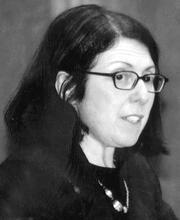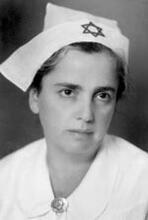Dore Jacobs
Dore Jacobs developed her own pedagogy, which viewed physical education as a holistic project, out of which came her own unique method of gymnastics. In 1923 Jacobs founded her School for Physical Education and Rhythmic Development. She took a critical stance towards existing trends in gymnastics, including the pedagogy of Nazi Rudolf Bode. Jacobs and her husband Artur were among the founding members of the Bund-Gemeinschaft für Sozialistisches Leben, a Marxist organization with a Kantian ethic. Jacobs survived the Holocaust through the support of a network of her friends; though her school closed, the Bund continued to exist secretly until 1945 as a fighting organization and a refuge for members. In 1945 Jacobs reopened her school and in 1962 she completed a book on her pedagogy called Die menschliche Bewegung (Human Movement).
Dore Jacobs was the inventor of a little-known method of physical education that became a mode of resistance under Nazism and is still taught in Germany, in the very same place in which it originated decades ago.
Education & Development of Pedagogy
Deborah (Dore) Marcus was born in Essen on June 27, 1894, the eldest of three children. Her siblings were Eva (b. 1896) and Robert (b. 1901). Dore’s father, Ernst Marcus (1856–1928), a judge and expert on Kant, and her mother, Berta, née Auerbach (1869–1918), founder of an association for the defense of women’s rights, were born in Westphalia. Born into an assimilated environment, Dore received no religious education but as a student attended lectures by Martin Buber and belonged to the Blau-Weiss Zionist organization. Since girls’ schools were not yet widespread, she studied at home with a dozen or so other pupils, under the instruction of Artur Jacobs (1886–1968), a young teacher and educational councilor at the city’s Goethe Gymnasium, a lecturer on Kant, and a fervent advocate of innovative, non-authoritarian educational methodology. After taking her school-leaving examinations, Dore began to study mathematics and physics at Heidelberg University, but very soon switched to join the new Helleran rhythmics institute founded by the celebrated Swiss pedagogue, Emile Jacques Dalcroze (1865–1950).
In 1914, having attained certification in rhythmics, Dore returned to Essen and married her former teacher, Artur Jacobs. Four years later she gave birth to a son, Gottfried. During World War I and the years that followed she completed her education at the Schlaffhorst-Anderson school for breathing and developed her own method of gymnastics while giving courses for pupils and instructors in numerous adult education institutions in the region. Movement rather than rhythmics was what interested her. What she sought was “Learning how to move” rather than “learning movement.” She conceived of physical education as a holistic project for the human being. “Movement is always the expression of the entire person. It is the language of humankind. It is the instrument by which a being expresses what makes him live and act.” Favoring the flowering of the senses as well as intellectual maturing, encouraging the individual’s creativity and his/her capacity to act within the community—these were her goals.
Founding her School
In 1923 Jacobs founded her School for Physical Education and Rhythmic Gymnastics, which was designed to introduce amateurs to her methods. It received state accreditation in 1925, when she changed its name to the School for Physical Education and Rhythmic Development, opening it up to children and adults, amateurs and future teachers, with especial attention being paid to the handicapped and the sick. Studios for music and singing, painting and sculpture were added to the gymnastics, as also were courses in the natural sciences, mathematics, history, philosophy, and religion. All this without neglecting outings to the countryside and parties with improvised games. Artur Jacobs’s reflections on education imbued the school’s philosophy. At the same time, he himself promoted within the adult education movement the idea of developing free communities functioning according to interdisciplinary principles and equality of girls and boys.
During the 1920s, Jacobs adopted a critical stance vis-à-vis the existing trends in gymnastics, which she considered too systematic, based on a performative conception of the body, or too mystical, based on irrational beliefs. (She was especially critical of Rudolf Bode, the Nazi founder of Ausdruckgymnastik, Expressionist Gymnastics.) The originality of her pedagogy lies in her precise observation of interaction between the circulatory, respiratory, and muscular systems. In her opinion, movement finds its equilibrium in the interaction between the “internal movement,” regulated by circulation of the blood and by breathing, and the “external movement,” determined by the muscles. It is in this interaction, the basis of physical bearing, that the individual can be perceived in his/her globality: “Only in the interaction between the interior and the exterior is something created that resembles the Image—in the sense of human movement, the goal of which is the human being and not only his/her movement-apparatus.” Though her teaching, based on interiority, improvisation, observation, the ability to experiment, and relation with the Other, Jacobs promoted her pupils’ development of an awareness of their own physical sensibilities and encouraged them to integrate this awareness into their everyday lives.
The Bund & The School as A Way of Life
Dore Jacobs’s work cannot be understood unless it is seen within the context of the social network and political orientation of the school’s members. Around Artur and Dore Jacobs there arose a circle of friends who, in 1924, constituted the founding members of the Bund-Gemeinschaft für Sozialistisches Leben (The Community Association for Socialist Life). Inseparable from the school, the Bund aimed to develop, via practice, a “form of socialist life which would integrate the entire human being, body, mind and soul.” While championing the Marxist analysis of society, it also invoked a Kantian ethic, according to which everybody can act freely so long as his/her own maxim can be elevated into a general law. The Bund was affiliated with no party and had no organized form, but many of its members were also members of the SPD (the German Socialist Party), the KPD (the German Communist Party), or the trade unions. This project of living socialism in a democratic community at first took the form of Sunday meetings where participants discussed gender equality, problems arising from racism, or education of young people.
In 1927 the school moved to an enormous house in the forest near Essen, making it possible to put some of their ideas into practice. Several members lived there as a collective (without free love) while two additional houses, in Essen and Wuppertal, welcomed smaller communities. Beginning as a circle of about ten, the Bund soon numbered 100 members with groups in the entire Ruhr region, in Göttingen, Braunschweig and Hamburg. Here teachers at the Volkshochschule (Adult Education Institute) met workers from the poorer districts and women whose origin was in the bourgeoisie. In this context, Jacobs played a prominent political role. The School rarely participated in political demonstrations, but its work—notably that related to “Movement Choirs”—became part of a holistic project of reforming social life. It was in their own individual physical experience and the rapport with each other that every member of the Bund could find everyday solutions to problems posed by modern life in the large industrial cities.
Survival & Resistance during the Holocaust
This work clashed dramatically with Nazi reality. Jacobs’s socialist philosophy was out of place in the authoritarian landscape of the Third Reich. The school closed in April 1934, but the Bund, which had no official organizational status, continued to exist in secret until 1945. Artur Jacobs, a non-Jew but known for his socialist views, had to go into hiding for several months and lost the pension he had received under the Weimar Republic. Dore survived by giving private lessons in politically-safe families, but she suffered from malnutrition and sickness. Their son joined a Quaker community in Holland. Interned by the Germans, he barely survived. Numerous members of the Bund went into voluntary exile. During the war eight Jewish members, including Dore, escaped the Holocaust thanks to the support of a network of their friends, who hid them and cared for their needs.
During these Nazi years the Bund became not only a fighting organization but also a refuge in the midst of uprooting, where members could gain strength to preserve their faith in the future. The members tried to maintain the life-style inaugurated in the 1920s by protecting themselves from denunciations and by learning to decode the totalitarian practices of the regime with great precision. Artur Jacobs, whose intellectual role was central during this period, testified: “Even physical education became an illegal occupation. Here, in the midst of a desert of ‘toeing the line,’ there sprang up an oasis of creative life. New paths were formed, a new image of man and his physical appearance and spiritual nature became visible, which awoke within us a disquiet and longing for a different world.”
After the war Dore and Artur Jacobs returned from Meersburg, near the Bodensee, where they had been hidden. The school reopened in October 1945. Dore Jacobs completed her book on pedagogy, Die menschliche Bewegung (Human Movement), drafted in the 1930s. Published in 1962, it became a reference book. She died on March 5, 1979. Her school lives on.
Selected Works
Die menschliche Bewegung. Essen: 1962, 1977, 1983, 1978, 1985.
Karin, Gerhard, and Ingrid Schierenberg. Für Dore Jacobs: 1894–1994. Essen: N.p., 1994.
Bramesfeld, Else, ed. Gelebte Utopie. Aus dem Leben einer Gemeinschaft. Nach einer Dokumentation von Dore Jacobs (Lived Utopia: The Life of an Association, after documentation by Dore Jacobs). Essen: Klartext, 1990.
Roseman, Mark. “Ein Mensch in Bewegung [A Being in Movement]. Dore Jacobs, 1894–1978.” In Essener Beiträge 114 (2002): 73–108.











